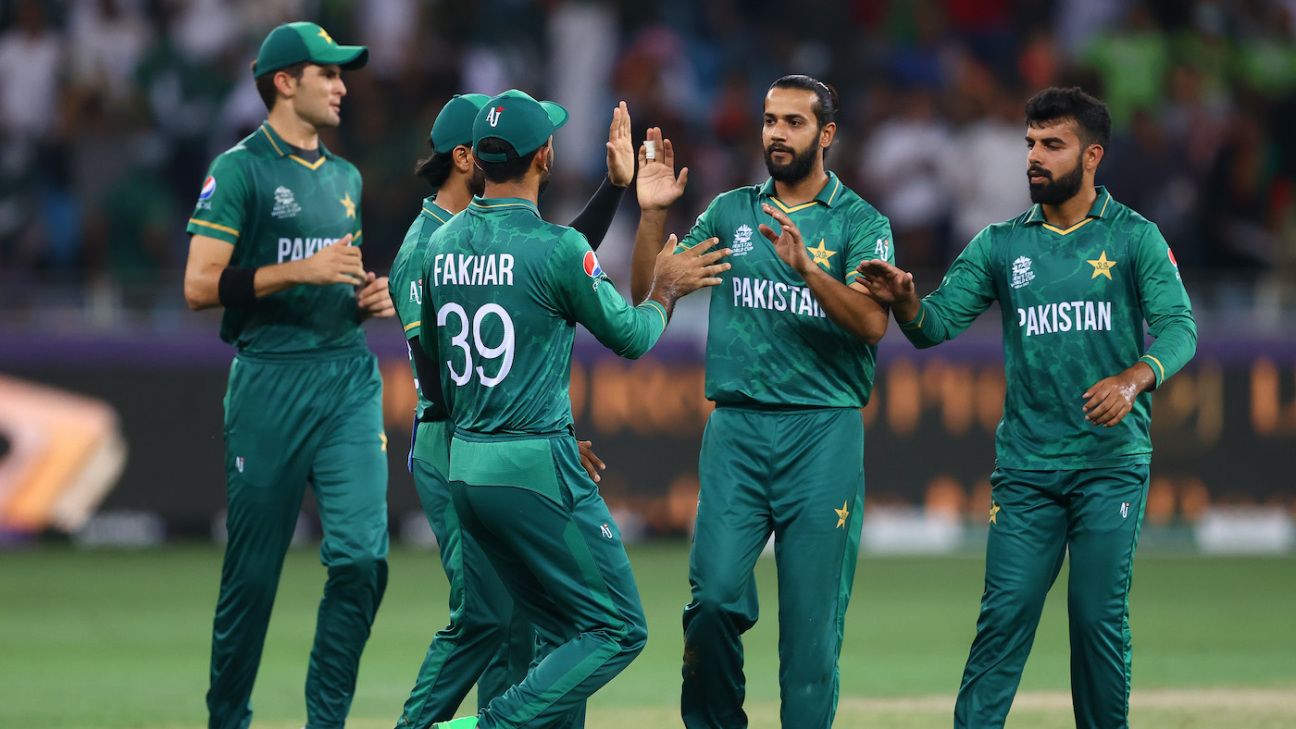
Big picture
Other than “Shaheen Afridi has a niggle” or “Mohammad Hafeez wants to open the batting”, there’s little that makes Pakistan fans break out in a cold sweat than the words “T20 World Cup semi-final vs Australia”. Even amongst the panoply of inexplicable heartbreak Pakistan cricket has subjected its followers to, Gros Islet in 2010 commands a unique psychologically damaging place.
Coming into the World Cup, Australia were plagued by concerns around their form. The batting order felt all wrong; they were too many anchors and openers jammed into the middle order. Josh Phillipe’s non-selection seemed to compound the problem of too few power hitters, while the express pace Australia packed in their fast bowling attack didn’t look as if it was built for the UAE.
It seems like the sort of thing you’d say about their trans-Tasman neighbours, but Australia are playing like a team better than the sum of their parts. With more ICC trophies than the other three semi-finalists combined, the business end of the tournament seems like a bad time to run into Australia.
Then again, this isn’t the nicest time to stumble upon Pakistan, either. Babar Azam’s side have rolled back the years as if it’s the Mickey Arthur era all over again, finding the formula that has made them invincible in the UAE for the last half-decade. A 10-wicket thumping of India put every other side in the tournament on notice, and a blistering group stage sees them become the only side to arrive at the semi-finals with a 100% win record.
For a side as flamboyant as Pakistan – in the past, anyway – there is a cold, methodical aspect to the way they have done their business at this tournament. Shaheen Afridi picks up the early wickets or stifles the openers, leaving the opposition with much catching up to do just as Haris Rauf is getting properly warmed up. With the bat, Mohammad Rizwan and Babar set a platform – without fail – leaving Hafeez, Shoaib Malik and Asif Ali to take turns scything through the bowling. The roles are exquisitely clearly defined, and the execution is forensic.
It seems, at times, as if Pakistan can’t lose in the UAE. But in Australia they’re up against a team they can’t ever seem to beat in these circumstances. How’s that for a scene setter in Dubai?
Form guide
Australia: WWLWW (last five completed matches, most recent first)
Pakistan: WWWWW
In the spotlight
Alongside Pakistan, Australia are perhaps the most top-heavy side this tournament; 402 of the 640 runs they have scored this tournament have come from the top three. The only two occasions the middle order was forced to bat came against South Africa and England, and Australia struggled to pile on the runs. If Afridi can make inroads against Finch, David Warner and Mitchell Marsh early on, Pakistan’s bowlers should fancy their chances against the men that follow, especially since having limited competitive match practice isn’t the best preparation to facing this Pakistan bowling attack. Equally, though, should Australia see off Afridi’s first spell, as each of New Zealand, Namibia and Scotland managed to do, then Pakistan find themselves up against an opposition far more adept than those three at taking advantage of wickets in hand.
Team news
Australia have a balancing problem with their squad, at times preferring the extra seam bowler, and others one more spinner. They do seem to have settled on their combination, though, and should be unchanged.
Australia (probable): 1 David Warner 2 Aaron Finch (capt) 3 Mitchell Marsh 4 Steve Smith 5 Glenn Maxwell 6 Marcus Stoinis 7 Matthew Wade (wk) 8 Pat Cummins 9 Mitchell Starc 10 Adam Zampa 11 Josh Hazlewood
It has never been easier to predict Pakistan’s line-up; they are the only side in the semi-finals to have made no changes to their starting eleven. With five wins in five, they are not about to start now.
Pakistan (probable):: 1 Babar Azam (capt) 2 Mohammad Rizwan (wk) 3 Fakhar Zaman 4 Mohammad Hafeez/Haider Ali 5 Shoaib Malik 6 Asif Ali 7 Shadab Khan 8 Imad Wasim 9 Hasan Ali/Mohammad Nawaz 10 Haris Rauf 11 Shaheen Shah Afridi
Pitch and conditions
The pitch to be used for the semi-final has seen three previous uses, with the evidence suggesting it should be good for batting. Dew, though could be a factor, making the toss especially important.
Stats and trivia
Quotes
“What we’ve seen over the course of the tournament is how important the powerplay is for batting and bowling. I think the stats around the middle overs and the death overs are pretty similar throughout, but the powerplay definitely holds the key. Shaheen has been in really good form for Pakistan, so that’s going to be a crucial battle no doubt.”
Australian captain Aaron Finch recognises the importance of winning the battle against Shaheen Afridi at the top of the order
Danyal Rasool is a sub-editor at ESPNcricinfo. @Danny61000
